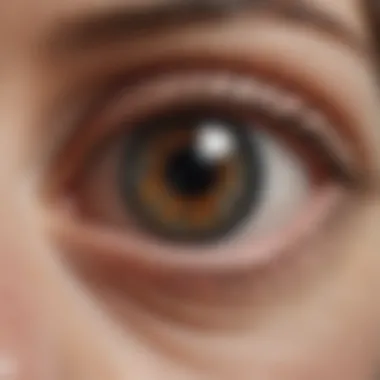Understanding Eye Color: Insights and Methodologies


Intro
Understanding eye color is a topic that merges genetics, anatomy, and physiology. It is not simply about what color appears on the surface; it goes deeper into the biological frameworks that shape pigmentation. Each person's eyes reflect both genetic inheritance and environmental influences that combine to create a unique hue.
Identifying one's eye color involves more than visual examination. It requires examination of various factors including the melanin content in the iris and the scattering of light. This article aims to provide a comprehensive guide to determining your eye color by addressing key methodologies, focusing on how genetics, environment, and optical effects contribute to perceived color.
By the end of this exploration, readers will better understand the intricacies of their own eye color and learn how to accurately describe it.
Methodology
Overview of Research Methods Used
Research surrounding eye color determination leverages a variety of methodologies. Genetic analysis stands as one of the most significant methods, enabling professionals to study the inheritance patterns of eye color traits. Researchers often utilize surveys and assessments to gather data on eye color perception within different populations.
Additionally, observational studies play a crucial role. These studies observe populations in diverse environmental contexts to note how lighting and surroundings impact perceived eye color. Such methodologies ensure a well-rounded approach to understanding variations.
Data Collection Techniques
Data collection for eye color studies often involves multiple techniques. These include:
- Surveys: Gathering subjective data on how individuals perceive their own eye colors and those of others.
- Photometric Measurements: Utilizing high-resolution imaging to document and analyze the eye's pigmentation under various lighting conditions.
- Genetic Testing: Collecting DNA samples to identify genes associated with specific eye colors.
Combining these techniques provides a holistic view of eye color, making it possible to understand underlying mechanisms better.
"Eye color is a complex trait influenced by multiple genes and environmental factors, making its study both fascinating and complex."
Future Directions
Upcoming Trends in Research
The future of eye color research points towards more integrated approaches. Utilizing advanced genetic sequencing technologies could unveil the vast genetic networks involved. Moreover, cross-disciplinary studies incorporating psychology and anthropology could enrich understanding beyond biological factors.
Areas Requiring Further Investigation
There remains much room for exploration in the field of eye color genetics. More comprehensive studies focusing on underrepresented populations need to be conducted. Additionally, investigating the psychological implications of eye color preference would add depth to current knowledge.
For more information, visit Wikipedia, Britannica, Reddit, and Facebook.
Foreword to Eye Color
Understanding eye color is not just an aesthetic curiosity. It involves substantial biological and genetic insights, which together elucidate why individuals possess unique eye characteristics. This article will delve deeply into the methodologies for identifying eye color with precision. The importance of knowing accurate definitions, genetic influences, and environmental factors will be highlighted.
Definition of Eye Color
Eye color is defined as the color of the iris, the circular part of the eye surrounding the pupil. This trait can display various hues, such as blue, green, brown, and gray. Each person's eye color is a combination of the amount and type of pigments present in the iris, primarily melanin, alongside structural traits of the eye that interact with light. For instance, the density of melanin in the front layer of the iris affects how light scatters, ultimately influencing the perceived color of the iris.
Importance of Identifying Eye Color
Identifying eye color goes beyond superficial interest. Here are a few significant reasons:
- Genetic Understanding: Identifying eye color can offer insights into genetic lineage and hereditary traits.
- Personal Health: Certain studies suggest that eye color may correlate with various health parameters, including sensitivity to light and potential predispositions to certain conditions.
- Cultural Relevance: In many cultures, eye color holds social significance, impacting perceptions and stereotypes.
Incorporating a scientific understanding of eye color can empower individuals to appreciate their unique traits while discussing broader genetic diversity.


"Knowledge of one's eye color is not merely a fact but could unravel deeper insights into genetic heritage and health."
As we progress through this article, we will dissect the elements of eye color identification, including its genetic foundation, methods of assessment, and common misconceptions.
Genetics and Eye Color
Understanding genetics is fundamental to grasping how eye color is determined. Genetics shapes not just individual appearance but also contributes to broader discussions about diversity and variation in human traits. Eye color, an outward manifestation of genetic makeup, particularly highlights the intricate connections between genes and phenotypes. For instance, eye color can be one of the first traits people notice in others, making it a topic of great interest in both scientific and sociocultural contexts.
The genetic basis of eye color can provide insights into ancestry, ethnicity, and even societal biases. This knowledge is vital for anyone looking to delve deeper into the topic, including students, researchers, and educators who aim to understand the biological underpinnings of human individuality.
Genetic Variation in Eye Color
Genetic variation is the cornerstone of diversity in eye color. The eye's pigmentation results from a complex interplay among multiple genes. At least 15 genes are identified as significant contributors to eye color, with the two primary genes being OCA2 and HERC2. These genes are located on chromosome 15 and significantly influence melanin production.
Melanin is the pigment responsible for the color of the eyes, skin, and hair. Higher levels of melanin lead to darker eye colors such as brown, while lower levels result in lighter shades like blue or green. Variations in these genes account for the broad spectrum of eye colors seen globally, which can change due to environmental factors or even age.
Dominant and Recessive Genes
When discussing eye color, the concepts of dominant and recessive genes are critical. Generally, brown eyes are considered the dominant trait, while blue and green are recessive. This means that a person will often inherit the brown eye trait if at least one parent carries the gene for brown eyes.
This genetic framework leads to a higher prevalence of brown eyes across populations but does not negate the existence of other colors. The recessive traits emerge more prominently when both parents carry the gene for lighter eye colors. Geneticists can trace patterns of inheritance through family lineage to predict the likelihood of eye color based on parents’ genetic backgrounds.
Family Traits and Eye Color
Examining family traits reveals fascinating connections between genetics and eye color. Eye color often runs in families, which illustrates the inheritance patterns just discussed. By analyzing family trees, one can observe how traits are passed down through generations.
Key Points about Family Traits:
- Sibling Comparison: Siblings may have different eye colors due to the combination of genes received from parents.
- Parental Influence: Children may inherit eye color similar to that of their parents or a combination of both.
- Family Health History: Certain eye colors are linked to specific health conditions, reinforcing the importance of genetic background.
In summary, understanding genetics, particularly the roles of dominant and recessive genes, and family traits equips one with valuable knowledge about the origins of eye color. Such comprehension is not merely academic; it enhances personal insight into genetic heritage and identity, underscoring the importance of genetics in determining eye color.
Biological Mechanisms of Eye Color
Understanding the biological mechanisms that contribute to eye color is central to this exploration. Eye color is not merely a surface-level characteristic; it is a manifestation of complex biological processes. This section delves into the crucial elements that determine eye color, including the roles of melanin, structural coloration, and environmental influences. By examining these factors, we gain insight into how eye color is formed and altered, thus equipping ourselves with knowledge relevant to both personal identification and broader scientific discussions.
Role of Melanin in Eye Color
Melanin is the primary pigment responsible for the coloration of various tissues in the body, including the eyes. It exists in several forms, with eumelanin and pheomelanin being the most significant for eye coloration. Eumelanin is responsible for darker shades, such as brown and black, while pheomelanin contributes to lighter shades, such as green and blue.
The concentration and distribution of these melanins in the iris affect the overall eye color. For instance, a high concentration of eumelanin results in brown eyes, while lower concentrations lead to lighter colors. Genetics plays a significant role here, as different genes control the quantity and type of melanin produced in the iris. This genetic determination leads to variation in eye color among individuals.
Structural Coloration and Its Effects
In addition to melanin, structural coloration also contributes to eye color. This phenomenon occurs when the microscopic structure of the iris interacts with light, causing certain colors to be amplified or muted. For example, blue eyes often result not just from the amount of pigment but also from how light scatters off the iris. Light scattering is influenced by the physical structure of the iris, where the layers can refract light in specific ways.
This structural aspect is crucial to understanding why some individuals perceive color differently under varying lighting conditions. While melanin gives a base color, the structural characteristics of the eye can modify that perception, leading to variations even among people with similar amounts of pigment.
Environmental Influences on Eye Pigmentation
Environmental factors also play a role in eye color, although their effects are generally more subtle compared to genetic factors. Ultraviolet light exposure can lead to increased melanin production, possibly darkening the iris over time. Seasonal changes and even nutritional factors can also influence pigmentation, although these effects may be minor.
For example, studies suggest that people who spend more time in bright sunlight may develop slightly darker eyes due to the body's response to increased UV exposure. Additionally, some research indicates that diet can impact melanin levels, although this area is still under exploration.


Understanding these biological mechanisms is crucial for comprehending individual differences in eye color.
By recognizing the interplay between genetic, structural, and environmental factors, we gain a clearer picture of how eye color can vary and evolve throughout life.
Assessing Your Eye Color
Assessing your eye color is not just an exercise in vanity; it serves multiple practical purposes. Understanding eye color can enhance personal health awareness since certain colors correlate with inherited traits and conditions. For instance, lighter eye colors might indicate a higher risk for certain ocular diseases. On a personal level, knowing your eye color can support proper techniques in makeup and fashion choices, and it can foster recognition in the context of social interactions. Understanding how to assess eye color accurately is crucial for clarifying misconceptions and making informed decisions in these areas.
Visual Observation Techniques
To begin assessing eye color, one should start with visual observation. This method relies on simply looking at the eyes under standard conditions. It requires no special tools and can be done anywhere. However, the key to accurate observation lies in taking note of the lighting and surrounding environment.
- Direct Gaze: Look straight at the person or yourself in a mirror without obstructions. Take a moment to let your eyes adjust to the sight.
- Focusing on the Iris: The iris is where the true color lies, make sure to focus on that area instead of the pupil.
- Comparative Observation: Sometimes comparing eye colors with others may offer a better perspective, although this can be subjective.
These techniques do require practice to develop a discerning eye for detail but can yield surprising clarity regarding individual variations in a person's eye color.
Using Natural Light for Accurate Assessment
Natural light is perhaps the best avenue for achieving an accurate assessment of eye color. Artificial lighting can distort the colors significantly. Sunlight offers a full spectrum of light, allowing the true colors to emerge. To utilize natural light effectively for eye color assessment, consider the following:
- Choose the Right Time: Midday sunlight, when the sun is at its peak, provides optimal conditions for color perception.
- Positioning: Stand near a window or outdoors. Face toward the light source to ensure the eyes catch the light without causing glare.
- Minimize Shadows: Shadows can obscure the true color of the iris. Move so that shadows don’t fall on your face.
This approach often reveals subtleties in eye color that may not be apparent in less ideal lighting.
The Role of Background Colors
Background colors can greatly influence how we perceive eye color. Different shades can either enhance or dull the apparent color of the iris. Here are some crucial factors to keep in mind:
- Contrast: Bright or contrasting backgrounds can make the iris color pop. For instance, if someone with blue eyes stands before a yellow wall, their eye color may appear more vibrant.
- Warm vs. Cool Tones: Warm backgrounds can enhance warmer eye colors like hazel or amber. Conversely, cooler tones, such as gray or blue, may suit persons with green or blue eyes.
- Personal Clothing Color: The clothing color can also impact eye color perception. It is helpful to wear a color that brings out one's eye shade when conducting an assessment.
This influence of color perception validates the necessity of understanding the environment when assessing eye color. It can alter the appearance and might lead to a misunderstanding of one's eye color without deeper examination.
Common Misconceptions About Eye Color
Understanding eye color can be complex. Misinformation often clouds public perception of what determines eye color and its implications. Identifying these misconceptions is essential as it can lead to a deeper awareness of genetics and biology. This understanding can help individuals better appreciate the diversity and richness of human physiology.
Racial and Ethnic Myths
Several myths exist regarding eye color associated with specific races or ethnicities. The typical beliefs suggest that certain eye colors are superior or more common among specific groups.
- Blue Eyes and Northern European Descent: Many believe that blue eyes are predominantly found in people of Northern European ancestry. While it is true that blue eyes are more frequent in these populations, they can appear in individuals of diverse backgrounds due to genetic mutations and variations.
- Brown Eyes and Dominance: There is a misconception that brown eyes are inherently stronger or more dominant. This view stems from the understanding of genetic inheritance, where brown eye color is often a result of dominant gene expression. However, this does not mean individuals with blue or green eyes are in any way lesser or have weaker genetic material.
This misconception perpetuates stereotypes about ethnicity and may contribute to biases. Understanding the genetic foundations of eye color can diminish these unfounded beliefs.
The Influence of Contact Lenses
Contact lenses have revolutionized the way individuals perceive and alter their eye color. Many people use them to achieve different looks, yet this practice leads to misconceptions about the natural state of eye color.
- Change of Eye Color: While contact lenses can temporarily change the appearance of eye color, they do not alter the actual pigmentation of the iris. This distinction is crucial. Some may wrongly conclude that the new color is a natural occurrence when, in fact, it is a result of artificial enhancement.
- Permanent Changes: There are myths suggesting that frequent use of colored contact lenses can lead to permanent changes in one’s eye color. This belief is not supported by scientific evidence. Prolonged misuse or poor hygiene can lead to health issues, but not a change in the natural color of the eyes.
Technological Tools for Eye Color Analysis
Technological tools have significantly transformed how we analyze and understand eye color. In recent years, advancements in digital imaging and data analysis have made it much simpler to determine and document eye color with accuracy. This is valuable for various reasons, including genetic studies, personalized medicine, and even cosmetic purposes. The integration of technology into eye color analysis offers precision that traditional methods lack, ensuring that anyone can identify their eye color beyond mere visual observation.
Digital Color Analysis


Digital color analysis entails employing various imaging techniques to capture and assess the eye's color spectrum with high fidelity. Cameras using specialized filters can capture images that reveal subtle distinctions in pigment that may be invisible to the naked eye. Each eye has unique characteristics, influenced by genetics and environmental factors.
Some specific features of digital color analysis include:
- High Resolution: The ability to see fine details in the eye's structure and coloration.
- Quantitative Data: Measurements of color ratios, brightness, and contrast provide objective information.
- Data Storage and Comparison: Collected data can be stored and compared over time or across populations, facilitating research.
Despite its advantages, there are some considerations when using digital color analysis. Variability in lighting conditions and camera quality can impact the results. Thus, ensuring controlled settings during analysis is crucial to obtaining reliable results.
"Digital color analysis not only improves accuracy but also enhances our understanding of the genetic factors influencing eye color."
Mobile Applications for Eye Color Determination
The proliferation of smartphones has led to the development of mobile applications designed for eye color determination. These apps leverage the smartphone's camera capabilities and the computing power to analyze eye color in a user-friendly manner. Users can easily take pictures of their eyes in varied lighting conditions, and the app processes this data to offer an assessment.
Key advantages of mobile applications include:
- Accessibility: Users can access eye color analysis from anywhere, whenever they wish.
- Ease of Use: Many apps feature straightforward interfaces, guiding users through the process step by step.
- Community Features: Some apps allow users to share their results and discover how their eye color compares to others.
However, it is essential to approach mobile applications with caution. Accuracy may vary based on the app's design and the conditions under which the photos are taken. Thus, consumers should opt for well-reviewed applications that emphasize accuracy and reliability. Overall, these technological tools not only make eye color analysis more accessible but also add an interactive dimension to self-discovery.
Psychosocial Implications of Eye Color Perception
The perception of eye color extends beyond mere physical characteristics. It influences social interactions, self-perception, and cultural identities. Understanding these psychosocial implications is crucial for comprehending how eye color affects individuals on personal and societal levels.
Cultural Reactions to Different Eye Colors
Eye color can elicit varying responses across cultures. For instance, in some societies, lighter eye colors, such as blue or green, are often viewed as markers of beauty and desirability. This association can stem from historical influences, media representation, and prevailing beauty standards. Conversely, darker eye colors like brown may be perceived as more common or conventional.
- Media Representation: Movies and advertising frequently portray characters with lighter eyes in roles symbolizing purity or superiority. This can lead to social privileging based on eye color, reinforcing biases.
- Cultural Beliefs: Certain cultures may attach specific meanings to eye colors. For example, in some African communities, lighter eyes may be considered signs of higher social status or sacredness.
- Perception Bias: Research indicates that individuals with lighter-colored eyes might be perceived as more attractive, often affecting their experiences in social settings.
This nuance in cultural reactions underscores the complexity of eye color perception, emphasizing its role in shaping personal identity and social interactions.
Stigmas and Biases Related to Eye Color
While some eye colors are favored, others face stigmas that can lead to biases in various aspects of life. These biases can manifest in different ways, affecting not just social relationships but also opportunities in professional and personal domains.
- Discrimination: Individuals with eye colors that do not conform to dominant societal preferences may experience discrimination. This can impact their self-esteem and mental health.
- Stereotypes and Assumptions: People may hold certain stereotypes based on eye color. For example, those with lighter eyes might be seen as less trustworthy or having a different temperament, based purely on visual perception.
- Social Cohesion: In some groups, differing eye colors can lead to social divisions, creating in-groups and out-groups based on physical attributes.
Understanding these biases is critical for fostering inclusivity and combating superficial judgments based on eye color.
Recognizing and addressing these psychosocial implications enhances conversational engagement and helps individuals navigate their interactions in a more informed manner. By dissecting these layers within the context of eye color, we initiate a conversation about broader societal issues related to physical appearance and bias.
End
Understanding the intricate layers of eye color extends beyond what meets the eye. Recognizing how one’s eye color is determined is essential in various fields such as psychology, genetics, and aesthetics. This article has delved deeply into the many dimensions that shape eye color, culminating in critical insights that can significantly enhance one’s awareness of their own phenotype. By providing a well-rounded overview combining methodologies, scientific backgrounds, and socio-cultural perspectives, readers are equipped to better articulate and appreciate their own eye colors along with those of others.
Summary of Key Findings
The exploration of eye color unravels a synthesis of genetics, biology, and environmental context. Some key findings in this article include:
- Genetic Influences: Eye color is predominantly determined by genetic variations that dictate the production and distribution of melanin within the iris.
- Environmental Factors: Systemic factors such as light exposure can influence the perception of eye color, leading to variations perceived by others.
- Technological Advances: Digital tools and applications are modifying how individuals assess and identify eye color accurately.
- Societal Implications: Eye color can carry cultural significance, impacting interpersonal perceptions and biases.
This highlights the multifaceted approach necessary for a holistic understanding of eye color, combining science with social perceptions.
Future Directions in Eye Color Research
Future research into eye color should emphasize interdisciplinary methodologies. Further investigations could take several directions:
- Genetic Studies: More nuanced genetic mapping can help understand rare eye colors and their implications.
- Psychological Impact: Exploring how specific eye colors affect societal interactions would provide deeper insight into human behavior.
- Technological Integration: Developing AI algorithms for advanced eye color analysis could lead to more precise identification methodologies.
- Environmental Studies: Understanding the long-term effects of sunlight and pollution on eye pigmentation forms another potential area of exploration.







